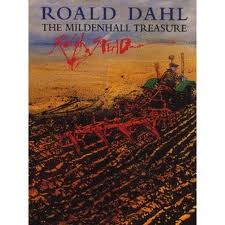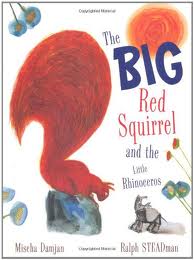Both of these books are long overdue. Not from publishers, from the library. They were checked out three weeks ago, read within days and have been sitting on my desk since then. So instead of being paid to review these, I’m now paying twenty-five cents a day per book. It’s tough that gold, not irony, is coin of the realm otherwise I’d be able to afford that flying pony Kidzilla wants for xmas.
There is no reason to spend much time on the texts. The Big Red Squirrel and the Little Rhinoceros was written by a Swiss publisher and is, despite its hyperbolic jacket text, pure crap. The Mildenhall Treasure is some decent reporting by Roald Dahl about a plowman’s January 1942 discovery of ‘the greatest treasure ever found on the British Isles.” The dwelling point here is Steadman’s styles in children’s book illustration separated by 35 years of craft and the effects of his being the birthing partner of Gonzo Journalism.
Published in 1999, The Mildenhall Treasure’s two–dozen illustrations are typical of Steadman’s well known style: thoughtful composition balanced with loose, seemingly frenetic, brushwork. His art here is a meatier, amped-up and menacing version of the skewed whimsy Quentin Blake did for most of Dahl’s other children’s books. For this story, Steadman’s style, not Blake’s, is the better fit. Steadman’s merciless portrayal of people reveales their deeper natures; his environmental palate is dark, muddy, and cold –– nicely mirroring the actual dirt of a winter farm and the moral grime of that greedy bastard, Sydney Ford.
The one thing Steadman’s style fails to showcase is the treasure’s true value — the fine craftsmanship of each of the recovered pieces. Images of the treasure seem to be cut outs from a museum catalog or enlarged photocopies gouached over to less-than-stellar effect. Random House targeted this book for kids. Younger readers will likely have a hard time figuring out what Steadman’s pictures of the treasure are supposed to depict.
Why Steadman didn’t use actual photos or execute clear and representative drawings, I don’t know. There is likely some bullshit copyright/intellectual property reason the British Museum wouldn’t clear images of the treasure for this book. Too bad. Those photos with Steadman’s paintings and Dahl’s text would have been a powerful combination.
The same cannot be said for The Big Red Squirrel. Steadman’s art is the only rationale this boring, hollow, let’s-all-get-along tale is back in print after 45 years.
This not so much a picture book –– where the words and images work together to create greater meaning –– as an illustrated story. The text spells everything out, leaving the artist to decorate the white space around the words. Ralph seems to have done the best he could with what he’d been given, managing to deliver better art than the story deserved.
Gouaches and inks were Ralph’s mediums for this book, too. And while there is a certain looseness, the paintings are still well-mannered. Few people familiar with his Gonzo and post-Gonzo styles would be able to pick these out of a line-up of his work. The crocodile and frog are the most memorable and many of the background animals are fun and eye-catching. The rest of the animals and many of the environments are muddy, uninspired and forgettable. Combine that with the puerile narrative and The Big Red Squirrel becomes less a curiosity than a boring artifact.

